
Airdate: December 5, 2015
Written by: Steven Moffat
Directed by: Rachel Talalay
The Story So Far: Previously on Doctor Who, Clara Oswald dies a fairly pointless death in a stunning burst of plot illogic and viewer disloyalty. The Doctor is then trapped and spends 2 billion years in a Matrix projection. before slowly punching his way through a diamond wall, to freedom, to… the planet Gallifrey.
Classic Doctor Who stories were heavily plot-driven. Every scene was plot, plot, plot, in service to the story..
Oh, sometimes a story would be drawn out to what we would now consider to be indecently distended lengths, but even the padding (typically lengthy capture/escape/capture loops) was meant to be in some sort of furtherance to the plot.
Steven Moffat doesn’t typically like to do plot. At his best, his episodes are incredibly tightly constructed pieces (The Girl in the Fireplace, Blink). At his worst, his episodes are … interestingly (yes, that will do) mismatched bits of crazy quilting, with off-the-wall scenes inserted into stories to lend fan service, or to lend short-term emotional boosts, which are then quickly forgotten in the next scene. Think the pointless appearance of American TV host Meredith Vieira in The Wedding of River Song, or the Immortal Space Cyber-Brigadier in Death in Heaven, or the Doctor momentarily sitting in Davros’ chair in The Witch’s Familiar.

Everybody had to cry, not a single eye was dry.
Which brings us to Hell Bent. Fresh off the emotional Clara death sequence, and a whole episode spent with Peter Capaldi trapped in an infinite Time Lord Matrix projection…. we open the Series 9 finale in a Wrangler Jeans commercial.
The Doctor arrives in “Jackson, Nevada”, strumming Murray Gold music on his electric guitar, while Clara, now a waitress in a 1950s-style American diner, engages in portentous small talk with him. She doesn’t seem to know who he is.
Cue the opening credits.

I was working as a waitress in a cocktail bar, when I met you
We resume the episode proper, back on Gallifrey. The Doctor wanders across the planet’s desert surface, until he reaches the abandoned barn in which much of the 50th anniversary special, The Day of the Doctor, was set (and also where a child Doctor was seen sleeping in Listen). Meanwhile, high atop the Gallifreyan Capitol building, the President (Donald Sumpter, who first appeared as a red shirt in a 1960s base-under-siege story, and who was last seen playing Pontoon as a prisoner of The Sea-Devils in 1972) is very worried, surrounded, as he is, by the ringing of the Cloister Bell, and by the acerbic appearance of Ohila, of the Sisterhood of Karn, first seen turning Paul McGann into John Hurt in the 50th anniversary webisode, The Night of the Doctor.
We’re now 10 minutes in, and almost everything that’s happened to date seems to be there intentionally placed to alienate and drive away the casual viewer. The Doctor is spotted in the barn by an orphanage matron, who’s not a bit unlike Charlotte Rae, girls’-school mother in the old U.S. sitcom The Facts of Life. Then he’s eating a bowl of orange soup outside the barn, surrounded by a bunch of Dickensian-looking orphans. A Gallifreyan weapons ship, which appears to have incorporated a viewscreen from Dalek technology, threatens him, but the Doctor wordlessly draws a line in the sand with his boot and returns to the table.
The President: What’s his plan?
Ohila: I think he’s finishing his soup.
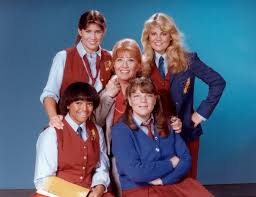
“Girls, girls, GIRLS!” sighed Mrs. Garrett for the umpteenth time…
I wondered at this moment, why all the hostility between the Doctor and Gallifreyans? When he last encountered them, in The Time of the Doctor, they rewarded him with regeneration. A complete new life cycle. Then, when he failed to find the planet in Death in Heaven, he had a near-mental breakdown. So now the episode up to this point was confusing the careful viewer, as well as the casual one. Does he blame the Time Lords for the Rube Goldberg-ian machinations that led to Clara’s death in Face the Raven? Does he blame them for his 2 billion years in captivity in the Matrix? He does spend a lot of time here clutching the Confession Dial and frowning, that much is clear.
The President, who’s never of the same temperament from shot to shot (never mind scene to scene), tries to shake the Doctor’s hand, and then orders his assassination. He wants information on The Hybrid, and actually has a squadron of reluctant Capitol Guards fire on the Doctor…

Donald Sumpter in happier days in The Wheel in Space.
… and cut back to that Nevada diner, again. There is no Jackson, Nevada, at least not in our dimension. But the Doctor sits there anyway, recounting the events of the previous scene to Clara, declaring them to have taken place in Space Glasgow (a callback to Sleep No More).
Clara: You like a cliffhanger, don’t you? … Is this a story, or did this really happen?
The Doctor: Stories are where our memories go, when they’ve gone.
Turns out all the Capitol Guards missed the Doctor — every army of soldiers in every sci-fi franchise ever has terrible aim, but here they’ve missed the Doctor on purpose, and in fact soon lay their arms at his feet.
The context is finally given here. The President is actually Rassilon (Timothy Dalton evidently having moved on from the role), and the decision to imprison the Doctor in the Confession Dial was his. The Doctor, however, is able to assume control of the planet, of the Presidency itself, and banish Rassilon and the High Council. The General, last seen in Day of the Doctor, and still played by Ken Bones, a bald Alan Arkin-looking dude (only more tan and rugged), counsels the Doctor’s on Rassilon’s obsession with The Hybrid.
The Doctor: What color is it?
The General: I don’t know.
The Doctor: Prophecies, they never tell you anything useful, do they?
Ohila: This is no time to play the fool.
The Doctor: It’s the end of the Universe, it’s the only time I’ve got!
The Doctor claims that he needs help in order to unravel the prophecy. He and the General then use Gallifreyan technology to extract Clara from “the end of her time stream”, allowing her to step out from seconds before the moment of her death in Face the Raven. The General believes that, once Clara reveals her information on The Hybrid, she must return to the moment of her death. But, it’s all a clever plan. The Doctor didn’t want information on The Hybrid after all — he wanted Clara back. Thus, he stages a mutiny, right there in the Extraction Chamber, and even breaks the very tense mood with two odd jokes:
The Doctor: On pain of death, no-one take a selfie!
The Doctor: We’re on Gallifrey! Death is Time Lord for man-flu!

If you enjoyed Ken Bones’ performance in Hell Bent… well, don’t get used to him.
The Doctor in fact has something even more drastic in mind than just cheating Clara’s death. He actually kills the General, to buy him time to escape with Clara. The General then regenerates into T’Nia Miller, a young black woman, which cheerfully spits in the eye of all those people who attend Doctor Who convention panels and insist that the Doctor must never be played by either a woman or a person of color. But the new General doesn’t have much to do over the rest of the story, unfortunately.
The Doctor then hides out with Clara in the Cloisters, a new wrinkle on Gallifreyan mythology: it’s a sort of Matrix prison, guarded by “sliders” (ghosts of dead Capitol guards with screaming, low-res faces) and also guarded by previous Gallifreyan invaders (Daleks, Cybermen, and Weeping Angels, primarily) who have been pressed into service as reluctant jailers. The Doctor gives a lengthy explanation as to what this means, which Clara, standing in for the audience, finds to be a bit too wibbly-wobbly-timey-wimey:
Clara: Was I supposed to understand any of that?
The Doctor: The Time Lords, they’ve got a big computer made of ghosts, in a crypt, guarded by more ghosts.
The Doctor then tells a story that’s presumably meant to describe what he was like back in his first incarnation. We learned in the previous story that he did not leave because he was bored, and once heard in the Tom Baker years that he was “kicked out” of Time Lord society… is this story, involving the Moon and the President’s daughter, the real reason he left?
The Doctor: I was a completely different person in those days. Eccentric. A bit mad. Ha ha. Rude to people!
And now, more than halfway through the episode, Moffat at last delivers the core of the story. Clara comes to realize that the Doctor has suffered greatly since she died, and that in fact he no longer even considers himself to be the Doctor. The new General and Ohila travel down to the Cloisters and reveal that the Doctor was trapped inside the Confession Dial for about four and a half billion years. Jenna Coleman gives a great teary-eyed performance, while a detached and impatient Capaldi is still trying to figure out a means to escape; he mentions his “duty of care” to Clara.

Note, however, that the 5th Doctor did not spend 4.5 billion years trying to save Adric… instead, he only spent 17 seconds, explaining to Tegan and Nyssa why Adric could not be saved.
There follows a nifty sequence in which Clara tries to refuse her rescue (and cheating death), and tells the Doctor some deep secrets, off-camera. Jenna Coleman has always given this show amazing performances, even when the writing is not always commensurate to her screen presence. She owns the second half of this story, just as much as Capaldi. I particularly enjoyed the scene in which she confronts the General and Ohila and calls them “monsters”. How does she get away with this? The Doctor has escaped the Cloisters in a service hatch while she was talking, stolen another TARDIS, and materializes it around Clara so that they can leave Gallifrey…
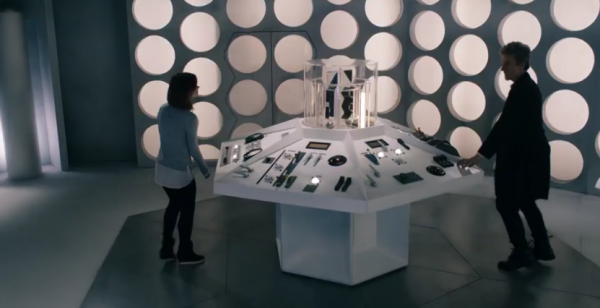
AND IT’S THE WILLIAM HARTNELL-ERA CONSOLE ROOM! OMG! THIS is what excited me most about the entire hour, this right here.
Capaldi then has a great moment, exulting over how he’s cheated Clara’s death, and restored her to life — she should no longer be frozen in time, without a pulse or breath, as the Extraction Chamber had left her. But the plan is then revealed to have failed. Even propelling the stolen TARDIS all the way to the final end of the Universe: Clara’s heart still hasn’t re-started and the countdown clock crudely inked on the back of her neck is still at “000”. The TARDIS finally arrives and someone knocks… four times…
And it’s Ashildr/Me/Maisie Williams, in a room at the end of the Universe, the last being left alive, with nothing left to do but watch the stars die. Ashildr and the Doctor take this opportunity to have a lengthy, largely visually static conversation about the nature of The Hybrid; he thinks it’s her, she thinks it’s him. Then they both come to realize that The Hybrid might actually be the team-up of the Doctor and Clara (as always, Moffat poses Clara Oswald as The Most Important Person In The Whole Wide Universe). The Doctor takes this realization and turns it into a vow, to evade the Time Lords by wiping Clara’s memory of him (“I’ve done it before”).
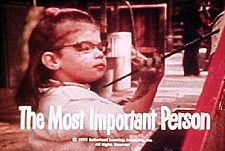
These 1972 film shorts, funded by the U.S. Government to air on Saturday morning children’s TV programs, would have been overseen by Richard Nixon; one assumes that the 18 1/2-minute gap on the Oval Office tapes was him complaining that the children just weren’t cute enough.
The Doctor: Look how far I went for fear of losing you. This has gone too far. One of us has to go.
There’s then a sort of game of Russian Roulette. The Doctor, having threatened to wipe Clara’s memory, inspires Clara to attempt to reverse the polarity of the memory-wipe device. If one of them presses the button, they won’t know whose memory will be wiped of the other. They finally agree to both grasp the device, and the Doctor pushes the reset button. Just about everyone who watched Face the Raven assumed that Clara’s death would be undone by a reset button… this is that button.
The Doctor loses; he’s the one who crumples. But, of course, has time for one last monologue before his memory goes; the monologue appears to owe a lot more to Paul Cornell than Steven Moffat:
The Doctor: Run like Hell. Because you always need to. Laugh at everything, ’cause it’s always funny. Never be cruel and never be cowardly, and if you are, always make amends. Never eat pears, they’re too squishy and they always make your chin wet – that one’s quite important, write it down. It’s OK, it’s OK, I went too far, broke all my own rules, i became The Hybrid. This is right. I accept… Smile for me, go on, Clara Oswald, one last time. Don’t you worry. I’ll remember it.
The Doctor then collapses on his back on the TARDIS floor, and Rachel Talalay has the camera pushed right in his face, in a direct mimic of William Hartnell’s death scene in The Tenth Planet.
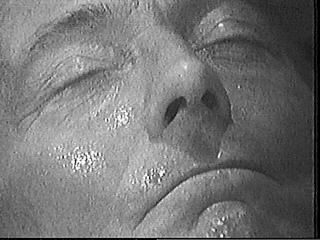
“I don’t want to go!”
The Doctor opens his eyes, and Clara’s face changes to that of an American tourist in the Nevada desert — we’re back to the Wrangler Jeans commercial.
And therein lies the episode’s final twist. All the time the Doctor was telling Clara the story in the Nevada diner, it wasn’t Clara who was amnesiac, it was him. He remembers that there was a Clara, but not what she looked or sounded like. He again strums the Murray Gold music, and Clara suggests that his memory has become a song, not a story.
Then she slips into the back of the diner — and it’s the stolen TARDIS, complete with Hartnell-era console room. Clara and Ashildr take off together, for a new lifetime of adventures. Clara’s still frozen in time, not aging, her heart still not beating (and saddled with that poorly-drawn tattoo), so she can travel for as long as she wishes before she returns to the moment of her death in order to face the raven. The new TARDIS’ chameleon circuit is stuck as an American diner, by the way, which is seen hurting through the Vortex.
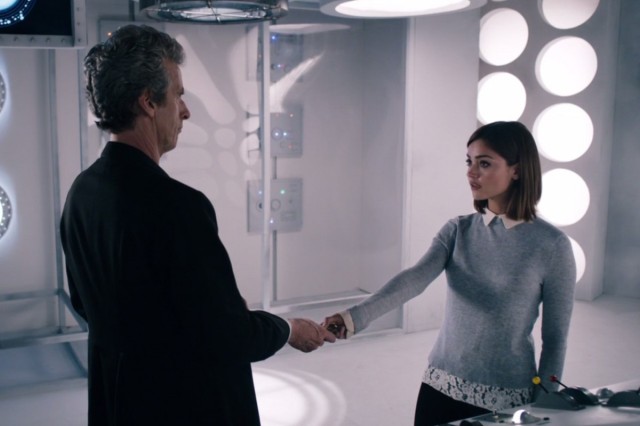
I mean, they even brought back the Fault Locator. I LITERALLY CAN’T EVEN.
And the Doctor is left alone in the Nevada desert, with his own TARDIS. Which still bears Clara’s likeness, thanks to Rigsy two episodes ago. Inside the TARDIS, Clara has left one final message on the chalkboard:
RUN, YOU CLEVER BOY. AND BE A DOCTOR.
The Doctor reclaims his sonic screwdriver, because Clara has taken the sonic sunglasses; he even reclaims his velvet coat. He dematerializes, and a CGI rendering of his TARDIS spins through the Vortex, too… passing Clara’s and Ashildr’s TARDIS diner as it spins in the opposite direction.

Not that TARDIS diner.
(Followed by a jarringly comic preview of The Husbands of River Song).
So… where does this leave us? It took a long time for Hell Bent to finish clearing its throat and tell its story. Much of the first 30 minutes were a nullity, set pieces with no payoff; Rassilon had no role in the story’s conclusion, and that Charlotte Rae-looking woman appears to have been a red herring (she’s billed only as “The Woman” in the end credits). The Cloister was a vivid setting, but again was there only as a piece of scenery and short-term atmosphere; ditto the room at the end of the Universe where the Doctor and Ashildr chat.
However, the whole point of the story was to resolve Ashildr’s and Clara’s fates, and this it does quite nicely. The two of them become, essentially, immortal time travelers in a Hartnell-era TARDIS diner. Clara will have to return to the moment of her death someday, but can do that whenever she’s ready, years or decades or centuries from now (she’s momentarily immortal). The Doctor gets to return to wandering and being heroic, his four and a half billion year oddysey to save Clara not having changed his core nature. The final 25 minutes of the episode are emotionally powerful.
Whether or not Hell Bent will hold up on rewatching, years from now, remains to be seen. For now, Rassilon is still out there, Gallifrey is still out there, but the Doctor has repudiated them, angrily, and it’s possible that the series will never have to revisit them. Moffat has, in short, wiped the boards clean of the last several years’ worth of his own continuity (it’s also implied that the TARDIS diner was the same one from The Impossible Astronaut, albeit it was in Utah instead of Nevada back then, so perhaps Ashildr and Clara go back to revisit old moments in the Doctor’s timeline). The series can do anything it wants, from this point. The next episode can choose to make sense to the casual viewer, unlike this one (once we get past the River Song Christmas special, that is). We can have a new companion; no more search for Gallifrey, no more sonic sunglasses.
(Of course, we still don’t know who The Hybrid is, or how it conquers Gallifrey……)
Wherever will the Doctor go next?
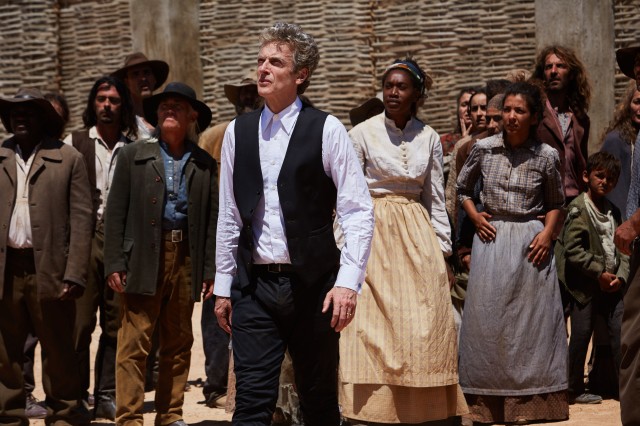
The Doctor could even join this crew of Dickensian Gallifreyan orphans and stage lavish musical numbers.
As for me, my next stop is the Planet of Evil. Which was everything Hell Bent is not. Next time, you’ll find out if I consider that to be a good thing…
I have to say I was quite pleased with the episode. I didn’t have such a problem with the first part of the episode, but I agree that the second half was much more emotionally packed. I am just so immensely glad that Clara got more than a useless death in the end. She was always heading towards becoming more like the Doctor and now … she just sort of is. I’ve read that a lot of people would have preferred her staying dead, but I much appreciate this version of events.
I really, really disliked her “death” in Face the Raven, so I’m glad that it was considerably blunted here. However, I have the sneaking suspicion now that, if you go back and watch the entire Clara era from end to end (starting with either “Asylum of the Daleks” or “The Bells of St. John”), there will be a TON of dangling threads that make positively no sense whatsoever. Including the temporal paradox of her having jumped into the Doctor’s timeline in “The Name of the Doctor”, and the miracle-baby resolution to the Danny Pink story arc at the end of “Death in Heaven” …….
We seem to agree on this episode. You’re right about the pieces not really adding up to much. There’s a series of people and events who are thrown in to the mix only to disappear or not really play an important part: Rassilon, Ohila, the General, the cloisters, Me/Ashildr…
Where the episode succeeded for me was in the relationship between the Doctor and Clara. You’re right about the emotional punch of the last 25 minutes. Plus, I was happy to see Clara get more than a tragically early death.
That’s not a still of Donald Sumpter!
Yeah, it is… not. Sorry. Posted that A) cos it was mislabeled on Google Images and B) because it was written before I started watching “Game of Thrones”, which is what I should have used (or… Commander Ridgeway himself).
Pingback: Doctor Who and the Sea-ocenes | Doctor Who Novels